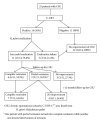The Clinical Correlations of Helicobacter pylori Virulence Factors and Chronic Spontaneous Urticaria
- PMID: 23956739
- PMCID: PMC3730156
- DOI: 10.1155/2013/436727
The Clinical Correlations of Helicobacter pylori Virulence Factors and Chronic Spontaneous Urticaria
Abstract
Background and Study Aims. The association between Helicobacter pylori (H. pylori) and chronic spontaneous urticaria (CSU) remains controversial. This study explored the role of H. pylori in CSU among different virulent genotypes patients. Patients and Methods. Patients infected by H. pylori were sorted into two groups as group A (with CSU) and group B (without CSU). The tissue materials were taken via endoscopy for polymerase chain reaction study to determine virulence factors. After H. pylori eradication therapy, the eradication rate and response of urticaria were evaluated by using C(13)-UBT and a three-point scale (complete remission, partial remission, or no improvement). Results. The results were comparable between patients of groups A and B in terms of H. pylori infection rates and eradication rate. Longitudinal follow-up of 23.5 months showed complete remission of urticaria in 63.6% but no improvement in 36.4% of the patients after H. pylori eradication. H. pylori infected patients with different virulence factors such as cytotoxin-associated gene A, vacuolating cytotoxin gene A signal region and middle region have similar remission rates for CSU. Conclusions. Current study suggests that H. pylori may play a role in the development and disease course of CSU but may be irrelevant to different virulent genotypes.
Figures


Similar articles
-
Systematic review and meta-analysis: Effect of Helicobacter pylori eradication on chronic spontaneous urticaria.Helicobacter. 2019 Dec;24(6):e12661. doi: 10.1111/hel.12661. Epub 2019 Sep 15. Helicobacter. 2019. PMID: 31523897
-
Positive Effect of Helicobacter pylori Treatment on Outcome of Patients With Chronic Spontaneous Urticaria.Am J Clin Pathol. 2021 Feb 11;155(3):405-411. doi: 10.1093/ajcp/aqaa134. Am J Clin Pathol. 2021. PMID: 32940336 Clinical Trial.
-
Effects of Helicobacter pylori Eradication in Chronic Spontaneous Urticaria: Results from a Retrospective Cohort Study.Am J Clin Dermatol. 2015 Dec;16(6):553-8. doi: 10.1007/s40257-015-0152-6. Am J Clin Dermatol. 2015. PMID: 26334425
-
The Effects of Antibiotics for Helicobacter pylori Eradication or Dapsone on Chronic Spontaneous Urticaria: A Systematic Review and Meta-Analysis.Antibiotics (Basel). 2021 Feb 4;10(2):156. doi: 10.3390/antibiotics10020156. Antibiotics (Basel). 2021. PMID: 33557074 Free PMC article. Review.
-
Is Helicobacter pylori infection associated with chronic idiopathic urticaria?Allergol Immunopathol (Madr). 2003 Jul-Aug;31(4):209-14. doi: 10.1016/s0301-0546(03)79180-0. Allergol Immunopathol (Madr). 2003. PMID: 12890412 Review.
Cited by
-
Relationship between Helicobacter pylori and idiopathic chronic urticaria: effectiveness of Helicobacter pylori eradication.Postepy Dermatol Alergol. 2015 Feb;32(1):15-20. doi: 10.5114/pdia.2015.48729. Epub 2015 Feb 2. Postepy Dermatol Alergol. 2015. PMID: 25821422 Free PMC article.
-
Extraintestinal manifestations of Helicobacter pylori: a concise review.World J Gastroenterol. 2014 Sep 14;20(34):11950-61. doi: 10.3748/wjg.v20.i34.11950. World J Gastroenterol. 2014. PMID: 25232230 Free PMC article. Review.
-
Association between Helicobacter pylori Infection and Chronic Urticaria: A Meta-Analysis.Gastroenterol Res Pract. 2015;2015:486974. doi: 10.1155/2015/486974. Epub 2015 Mar 16. Gastroenterol Res Pract. 2015. PMID: 25861258 Free PMC article.
-
Helicobacter pylori and autoimmune disease: cause or bystander.World J Gastroenterol. 2014 Jan 21;20(3):613-29. doi: 10.3748/wjg.v20.i3.613. World J Gastroenterol. 2014. PMID: 24574735 Free PMC article. Review.
-
Beyond the stomach: an updated view of Helicobacter pylori pathogenesis, diagnosis, and treatment.World J Gastroenterol. 2014 Sep 28;20(36):12781-808. doi: 10.3748/wjg.v20.i36.12781. World J Gastroenterol. 2014. PMID: 25278678 Free PMC article. Review.
References
-
- Ring J. Allergy in Practice. Berlin, Germany: Springer; 2005.
-
- Zuberbier T, Asero R, Bindslev-Jensen C, et al. EAACI/GA2LEN/EDF/WAO guideline: definition, classification and diagnosis of urticaria. Allergy. 2009;64(10):1417–1426. - PubMed
-
- Nichols KM, Cook-Bolden FE. Allergic skin disease: major highlights and recent advances. Medical Clinics of North America. 2009;93(6):1211–1224. - PubMed
-
- Philpott H, Kette F, Hissaria P, Gillis D, Smith W. Chronic urticaria: the autoimmune paradigm. Internal Medicine Journal. 2008;38(11):852–857. - PubMed
-
- Konturek SJ, Konturek PC, Konturek JW, et al. Helicobacter pylori and its involvement in gastritis and peptic ulcer formation. Journal of Physiology and Pharmacology. 2006;57(supplement 3):29–50. - PubMed
LinkOut - more resources
Full Text Sources
Other Literature Sources

